Moroccan food
North of Africa is one of the most charming countries of the entire continent and which has been heir to a huge cultural legacy that combines Muslim, Mediterranean, and African traditions. That’s right, we are talking about Morocco, a charming country with a strong Arab character that keeps riches and treasures in each of its streets; one of these wonderful treasures is its cuisine, the typical dishes of Morocco are an excellent sample of gastronomic refinement that is worth knowing. It is for this reason that on this occasion, here in Morocco, we bring you this list of typical Moroccan food, so that you too can fall in love with the food of Morocco.
Typical food of Morocco: introduction to its gastronomy
As we said previously, this country is the result of a great sum of cultures and traditions, which is reflected in the food of Morocco, where we find the influence of gastronomic traditions from the Berbers, the Moors, the Middle East, the Mediterranean, and Africa, which makes the typical dishes of Morocco in a melting pot of flavors and sensations. Moroccan cuisine is closely related to other Maghreb cuisines, however, it retains great autonomy from the rest, as it was not greatly influenced by Turkish cuisine.
The typical food of Morocco basically focuses on four basic dishes that function as pillars: couscous, bastela, lamb mechui, and djej mcharmel, which are prepared with chicken, pickled lemons, and olives. In the typical dishes of Morocco, there is also an abundance of vegetables, which describes a clear influence of Mediterranean cuisine, among these, are eggplants, garlic, tomatoes, lettuce, onions, among others. It should also be noted that Moroccan food makes use of a large number of spices, most of which are produced in the country.
Top typical Moroccan dishes you should try
Couscous:
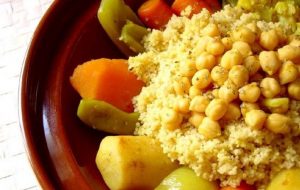
We start this count on the typical food of Morocco with one of the emblems of Moroccan cuisine, the famous couscous. This dish consists of durum wheat semolina that is accompanied by meat, vegetables, legumes, nuts or whatever the cook wishes to add. We could say that the couscous is a typical Moroccan dish that consists of hard wheat semolina grains, this is the main thing and for this reason, we will see it in other dishes of the Moroccan gastronomy,
Once all the ingredients are incorporated into the couscous it is proceeded to add spices, which, as we have said before, can be several in diverse proportions, nevertheless, a common one among these is the black sesame. Within the food of Morocco, there are two main varieties of Couscous, the one that is prepared with veal and the one that is prepared with chicken; the one of veal is more common and it is this one that is accompanied with vegetables; on the other hand, the one of chicken is usually accompanied with onions, raisins caramelized with cinnamon and chickpeas.
Moroccan Tajine (or Tagine):
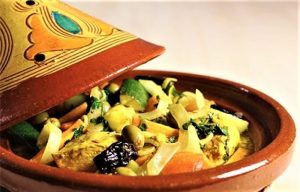
The following typical Moroccan dish has several particularities: first, it is not specifically a specific food, the name tajine refers rather to the container that holds the food; on the other hand, the spices are what make this dish exceptional and unprecedented. The Tajine is an earthenware container made in the shape of a plate and which has a cone that works as a lid and keeps the heat inside it, therefore, in effect, anything that is presented in this container could be considered as a tajine.

However this is not so true, the most common ones are vegetables, lamb and chicken tajine, although some riskier ones are made of tuna, argan, kefta or any other. What gives the magic to this dish is the Ras el Hanut, a particular mixture of spices that contains black pepper, coriander, turmeric, ginger, paprika, cinnamon stick, nutmeg, cardamom, and cumin. Basically, you chop the meat into pieces, fry it and add the Ras el Hanut, then the vegetables, another bit of the magic spice, and so on… Some people add nuts and other things. In short, this Moroccan food despite being one of the most popular is the most surprising, you will never know what yours will contain, the only thing you will know is that it is delicious.
Pastela:
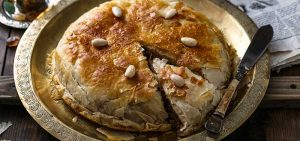
Pastella is a delicious puff pastry omelet stuffed with chicken, one of the most delicious exponents of Moroccan food, well, it is not really puff pastry, but to get an idea of the dough that makes up this dish, puff pastry will do. The dough used is called filo dough very common in Middle Eastern food, to the filling, in addition to the chicken (or pigeon) is also added parsley and almonds, which are also seasoned with cinnamon, which gives it a very particular and seductive flavor.
The pastry is also seasoned with Ras al Hanut, as a particular fact, this mixture is made up of between six and thirty different spices, so it is most likely not possible to try the same spice twice, this also fills with charm the typical dishes of Morocco. The form in which the pastelle is presented is also fascinating, as it looks like around and not a very tall cake that is cut into triangular portions. An exceptional Moroccan meal!
Harira:
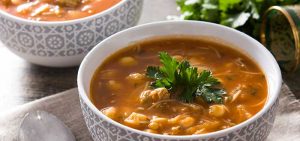
Among the typical dishes of Morocco, perhaps the harira is the most traditional. This consists of a soup that includes meat, vegetables, and legumes, which makes it have a high nutritional value as well as being tremendously delicious. This typical Moroccan food is consumed throughout the year, however, there is a greater presence of it on Moroccan tables during Ramadan, as it is with this soup that the fast is broken on these dates.
The traditional version of the harira can take about eight hours of cooking, so during this month of fasting the Moroccan streets exhale the lovely aroma of this soup. The soup has a thick and fascinating texture that is given by the skinless chickpeas and lentils, the meat that is mainly used is beef, although there may be some variations. This soup includes tomato, onion, celery, parsley, cilantro, pepper, and other spices that the cook deems conducive. It is very delicious and is a must when talking about Moroccan food.
Zaaluk:
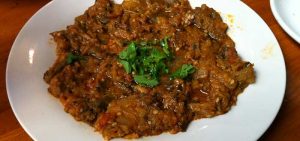
Imagine the following: it’s lunchtime and you are lost in the Medina of Fez together with your travel companions, you are already starting to feel hungry and suddenly someone offers you zaaluk with pita bread or corn tortillas… Or whatever, damn it! You and your companions receive it and in a strange cold mash. The riskiest one will be the first to taste this typical Moroccan food… “Wow, it’s really tasty!” he says. Then they will look at each other and think of all the surprises the typical Moroccan dishes have brought them, and you say “What’s the difference, let’s try it!”… “It’s delicious!”
So that you can better picture the scene, perhaps it is necessary to point out what zaaluk is. Zaaluk is the quintessential Moroccan food salad, this consists of a pureed eggplant salad to which olives are usually added and is bathed in an exquisite sauce made from tomatoes, garlic, and olive oil. Spices, sweet red pepper, and a glass of lemon juice are added to the sauce, which is then left to rest for a while and applied to the eggplants. Isn’t your mouth watering?
Bread (Khubz):

It is common when encountering the bread of other nations that they speak a lot about the history of a people, such is the case of the khubz bread, which should not be confused with pita bread, because, since they have a very similar taste, the khubz is more elongated and a little flatter. The khubz has been part of the typical dishes of Morocco for a long time and, since its early years, it was highly consumed by nomadic families crossing the desert, as this bread is baked without yeast and in a special stone oven, which keeps it in good condition for a long time.
The elaboration is quite simple and its ingredients only include normal and whole wheat flour, warm water and salt, that’s all. The magic lies in kneading it and leaving the strips as if they were a pizza, then crashing them into the stone oven and leaving them there until they start to bubble. This bread is a perfect accompaniment to typical Moroccan food, also because the result usually has some holes that were left by the bubbles and many introduce food here: Something like Moroccan food to fill with Moroccan food.
Maakouda:
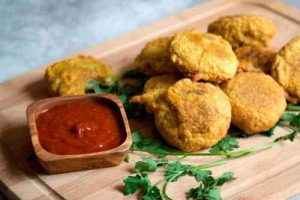
We continue our gastronomic tour through the typical food of Morocco with the Maakouda, a dish quite simple and quick to make, but loaded with exoticism and an unparalleled flavor. This dish basically consists of fried potatoes. Easy, isn’t it? Well, maybe a little more than that. The potatoes must be peeled and cooked, and once they are well cooked, they are mashed.
Once the mashed potatoes have cooled, add an egg and a little salt and mix until smooth. Obviously, as we have seen in all typical Moroccan dishes, spices must be added, although this dish is generally more sober in the use of spices, it is still exotic, as it only contains turmeric and cumin. Everything is mixed again and at the end, balls are made and fried. Ta da! Our Moroccan meal is finished. It is served with olives and pita bread.
Moroccan Salad:

Simple but tasty, Moroccan salad is prepared with just a few key ingredients: tomato, bell pepper, and onion, all finely chopped, flavored with cumin and coriander, and drizzled with a drizzle of olive oil.
Bissara:
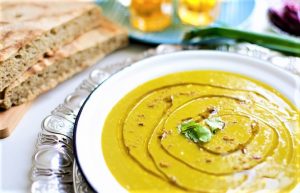
Bissara is so popular in Morocco that it is even found in their sayings, such as the one that says “he is so poor that he only eats bissara”, as it is a very simple dish, but the truth is that I loved it and it was very comforting.
It is a simple bean puree with a generous drizzle of olive oil that you will see served in many places for breakfast or as an accompaniment to other dishes. Don’t miss the opportunity to eat it with spongy Moroccan bread.
Mechoui:

A common food at weddings and large celebrations, mechoui is a whole lamb that is cooked slowly over coals on a fire. It takes on a smoky flavor from the coals and is cooked until the meat is tender and almost falling off the bone. The melt-in-the-mouth meat is seasoned with a pinch of salt and cumin.
Hummus:
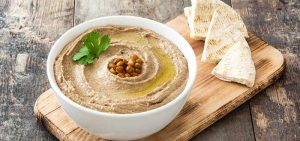
The next typical food of Morocco is the famous hummus, which consists of cream of mashed chickpeas cooked with lemon juice, also includes tahini paste (sesame seeds ground with liquid and salt) and olive oil, in addition, depending on its variant, also carries garlic or paprika. This dish is one of the oldest and dates back 7,000 years ago in ancient Egypt, the variants are many, however, it has managed to position itself fully and honorably among the typical dishes of Morocco.
It is served with fresh or toasted pita bread and is usually served as an appetizer or accompaniment to other meals, also spices such as cumin, coriander, or caraway are added. This Moroccan food is usually served cold and diners use it to dip bread, vegetables, or greens; there are also slightly more contemporary variants that instead of pita bread use tortilla chips to accompany it.
R’fissa:

R’fissa is a traditional Moroccan dish with Arabic roots. It is a type of stew made of lentils, chicken, fenugreek seeds, and mixed spices. The stew is served on a bed of shredded crepes. It has a lot of flavors and an interesting texture. It is especially popular in the winter months and at celebrations. R’fissa is common for people to eat the stew from a large communal dish.
Tangia:
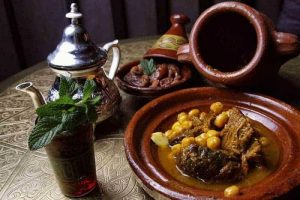
Tangia is a local dish from Marrakech. The food takes its name from the type of urn-type pot in which it is cooked. It is historically linked to souk vendors, as vendors would often prepare a pot for a picnic on their day off. The pot is filled with meat, lemon, salted butter, garlic, and spices, before being slowly cooked over charcoal. Traditionally, people would take their tangia to the local hammam (Moroccan steam bath) and let it cook on the coals heating the water.
Sardines:
With a coastline that stretches along both the Atlantic Ocean and the Mediterranean Sea, it is not surprising that fish and seafood are common in Morocco. Morocco is one of the world’s largest producers of sardines, and small fish are also enjoyed locally. Most common, naturally, on the coast, Essaouira and Safi are key places to enjoy tasty sardines. Place on a plate of grilled sardines with gusto.
chicken with almonds:
We close this article on typical Moroccan food (hungry, by the way) with one of the stellar Moroccan food: Chicken with almonds. Although this recipe is used in several Maghreb countries and even in the Middle East, the Moroccan variation keeps its main charm in the use of spices, which make it a festival of aroma and flavor.
The preparation of the chicken with almonds is simple but slow. First, the sauce is made by grating the onion, garlic, and parsley, to this we add olive oil, salt, and our magical Ras al Hanut. This sauce must be abundant because later a whole chicken is introduced and is totally bathed in the sauce, there are even those who introduce the sauce in the chicken. This chicken rests in the sauce for about ten minutes, then the fire is turned on and left another ten minutes; then half a liter of water is added per chicken, you have to let it cook well enough and once it has been well tender it is roasted. While the chicken is roasting the sauce is kept on so that it becomes thicker. Finally, the chicken is served, almonds and olives are applied and all this is bathed with our wonderful sauce. One of the most delicious dishes typical of Morocco.
And so we end our gastronomic tour through the typical dishes of Morocco, we hope you have craved and decide to travel to this magical country to try it all. Did you like the article? What was your favorite dish? Leave us your comment!







